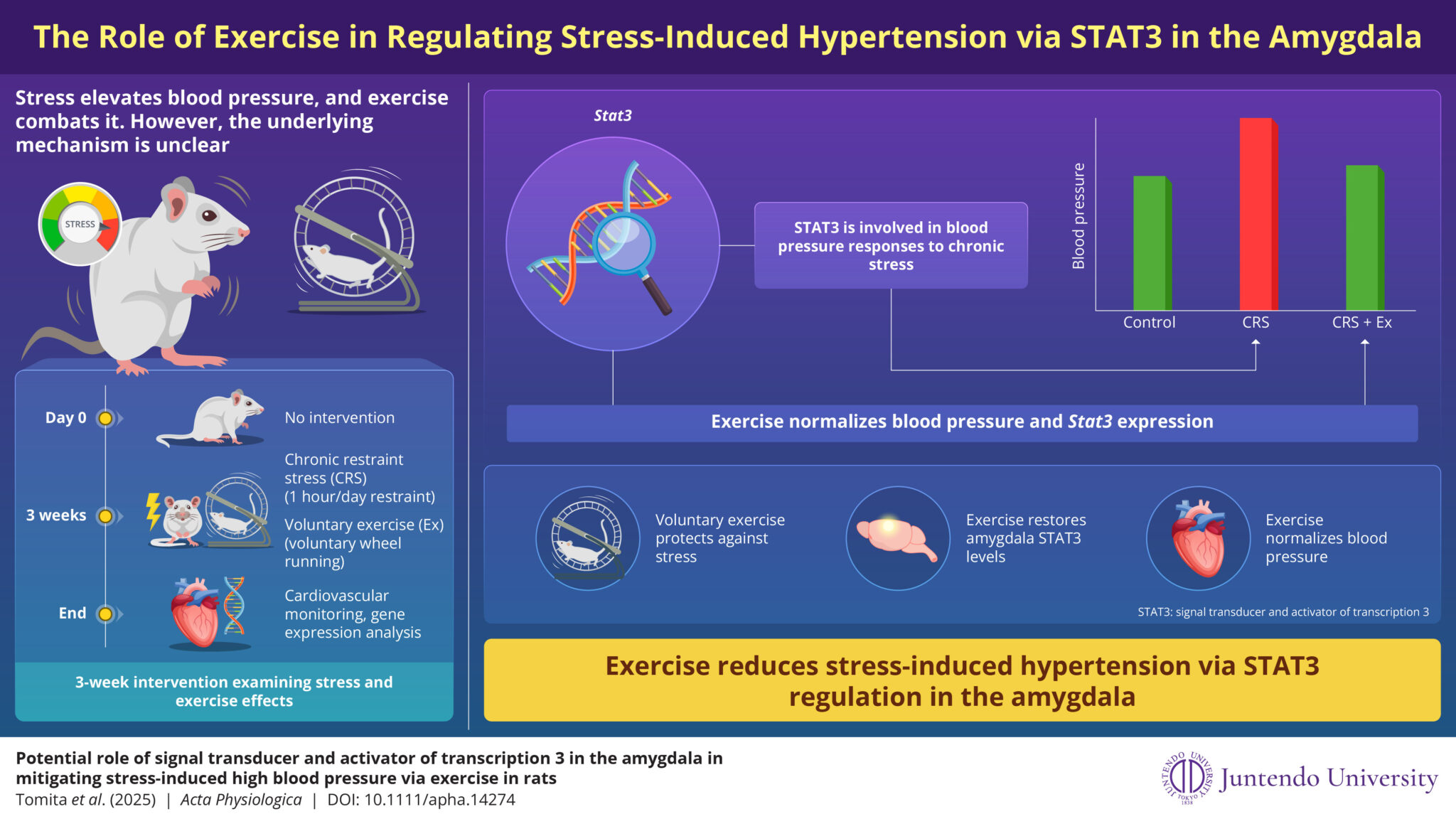New research uncovers how voluntary exercise restores STAT3 levels in the amygdala, preventing stress-induced high blood pressure


Chronic stress raises blood pressure. New research from Juntendo University, Japan, reveals that voluntary exercise prevents hypertension (high blood pressure) by restoring STAT3 levels in the amygdala. Using a rat model, the study found that stress lowered Stat3 expression, leading to increased blood pressure, while exercise reversed this effect. This discovery highlights a novel brain-based mechanism behind exercise’s cardiovascular benefits, opening doors for potential new therapies targeting stress-induced hypertension.
Hypertension (high blood pressure) is a debilitating condition and a major cause of premature death worldwide. Chronic stress plays a significant role, but the underlying mechanism involving biochemical pathways by which stress leads to hypertension has not been well understood. Understanding these pathways could lead to the development of therapeutic agents to combat hypertension. Now, a new study from Juntendo University, Japan, led by Professor Hidefumi Waki, Dr. Keisuke Tomita, and Dr. Ko Yamanaka, published online in the journal Acta Physiologica on January 13, 2025, has shown that voluntary exercise prevents stress-induced hypertension through restoration of amygdala signal transducer and activator of transcription 3 (Stat3), a gene that is crucial to the normal function of the amygdala, an almond-shaped part of the brain involved with the experiencing of emotions.
“In the amygdala, the gene Stat3 is involved in the regulation of blood pressure and possibly plays a role in blood pressure elevation in response to chronic stress. It might also be involved in the improvement of stress by voluntary exercise,” explains Prof. Waki while elaborating on the role of STAT3.
The amygdala is a key player in the body’s cardiovascular response. When exposed to prolonged stress, this region triggers an increase in blood pressure, heightening the risk of heart disease. To understand how exercise influences this process, researchers subjected rats to three weeks of chronic stress, with one group engaging in voluntary wheel running. Subsequently, they analyzed blood pressure levels and the levels of various genes using gene expression analysis in the amygdala to identify changes at the molecular level.
The study found that chronic stress led to a marked increase in blood pressure. Moreover, gene expression analysis revealed decreased Stat3 gene expression in the amygdala. However, when stressed rats underwent daily exercise, their blood pressure was normal, and STAT3 levels rebounded.
Subsequent experiments demonstrated that Stat3 expression blockade in the amygdala, in the absence of stress, produced an increase in blood pressure, underlining its important function in cardiovascular control.
“The improvement of cardiovascular dynamics after exercise is attributed to the rescue of Stat3 expression possibly because of mechanisms such as neuroprotection and anti-inflammation,” explains Prof. Waki while elaborating on the underlying mechanism.
The findings of the study highlight a previously unknown brain-based mechanism behind exercise’s ability to combat high blood pressure. While regular physical activity is already recommended for heart health, this study suggests it may also serve as a non-drug therapy for stress-induced hypertension and related conditions like anxiety. However, researchers caution that more studies are needed to confirm these findings in humans and to explore whether therapies targeting STAT3 could offer new treatments for hypertension.
“STAT3 plays a potential role in arterial pressure elevation in response to chronic stress and its improvement through exercise, both of which need to be clarified in future studies,” concludes Prof. Waki.
Next, the team plans to explore whether specific types of exercise—or even pharmacological approaches—can enhance STAT3 activity in the amygdala to offer protection against hypertension.
Overall, their research reinforces a simple yet powerful message: exercise is not just for your body—it’s for your brain too.

